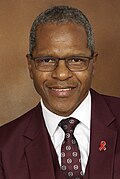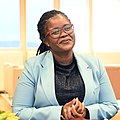Top Qs
Timeline
Chat
Perspective
Cabinet of South Africa
Cabinet of the national government of the Republic of South Africa From Wikipedia, the free encyclopedia
Remove ads
The Cabinet of South Africa is the most senior level of the executive branch of the Government of South Africa. It is made up of the president, the deputy president, and the ministers.[1]
Remove ads
Overview
Summarize
Perspective
The cabinet of South Africa consists of the president, deputy president, and ministers.[2] The president appoints the deputy president and ministers, assigns the ministers’ powers and functions, and may dismiss them.[3] The deputy president must be a member of the National Assembly.[4]
The president may select any number of ministers. The ministers must be selected from the members of the National Assembly, with the exception that up to two ministers may be selected from outside the assembly.[5] The deputy president and ministers may be from various political parties, reflecting the outcomes of the general election or coalition agreements. Members of the cabinet are accountable collectively and individually to Parliament for the exercise of their powers and the performance of their functions.[6]
The president must appoint a member of the cabinet to be the leader of government business in the National Assembly.[7]
The president appoints deputy ministers to assist the relevant ministers in the execution of their duties[8] but they are not members of the cabinet.[9] Deputy ministers must be selected from the members of the National Assembly. The exception is that up to two ministers may be selected from outside the assembly, but they are accountable to Parliament for the exercise of their powers and the performance of their function.[10]
The cabinet is responsible for the general direction and administration of the government of South Africa.
The composition and responsibilities of cabinet members and deputy ministers may be reconfigured by the president as required to enhance efficiency and address the nation's priorities. This reconfiguration is part of the president's executive powers to organize the government in a way that they believe will best serve national interests.[11]
The term of a previous president ends when the new president is sworn into office by the Chief Justice of the Republic.[12][13]
A cabinet member or deputy minister's term of office begins upon their swearing-in, not upon the announcement of their appointment by the president.[14] Their term of office ends when the new president is sworn in, including when a current president is re-inaugurated following an election.[15][13]
Remove ads
Current cabinet
Summarize
Perspective
President Cyril Ramaphosa announced his cabinet on 30 June 2024, sixteen days after being elected president of the 7th administration on 14 June 2024. The delay in settling the cabinet followed the ANC securing only about 40% of the vote in the May national election. When announcing the cabinet president Ramaphosa stated, "In casting their votes, the people [of South Africa] made it clear that they expect political parties to work together to deliver on a mandate of transformation, growth, and renewal. To give effect to this mandate, it was agreed that a Government of National Unity, which brings together parties from across the political spectrum, should be formed."[16]
This Government of National Unity (GNU) was formed by the African National Congress (ANC), Democratic Alliance (DA), Patriotic Alliance (PA), Inkatha Freedom Party (IFP), Good Party (Good), Pan Africanist Congress of Azania (PAC), Freedom Front Plus (FF+), United Democratic Movement (UDM), Al Jama-ah, Rise Mzansi (Rise) and UAT,[17] although the UAT withdrew on 12 July 2024 after it did not receive any positions in the Cabinet.[18] The partnership between the GNU parties is guided by a Statement of Intent, which outlines fundamental principles and a minimum programme of priorities.
The following table details the distribution of Parliamentary seats,[19] cabinet members (which include the president and deputy president), and deputy ministers among the parties currently in the GNU. The background colours in the table highlight the relative value of the numbers, with darker shades representing higher values. See below for proportions and ratios regarding these executive positions.
The Cabinet
After the 2024 national and provincial election, president Cyril Ramaphosa announced the GNU cabinet and deputy ministers on 30 June 2024.[17][20] The current members of the cabinet of the GNU are listed in the table below.[21] The deputy president and initial set of ministers officially took office upon their swearing-in on 3 July 2024.[22]
Deputy Ministers
Deputy ministers are appointed by the president of South Africa. They are not members of the cabinet. They assist cabinet ministers in the execution of their duties. The current deputy ministers are listed in the table below. The original group of deputy ministers officially took office upon their swearing-in on 3 July 2024.[22]
Proportions and ratios of positions as between GNU parties
The table below details the distribution of parliamentary seats, cabinet members, and deputy ministers among the parties of the GNU. The percentages represent the proportion of each category held by GNU parties only, excluding other parties in Parliament.[17] The background colours in the table highlight the relative value of the numbers, with darker shades representing higher values.
The table below illustrates the ratios of executive positions to Parliamentary seats among the parties of the GNU.[17] The background colours in the table highlight the relative value of the numbers, with darker shades representing higher values.
Remove ads
Changes to ministerial portfolios from 2009
Summarize
Perspective
The president may restructure cabinet at his discretion, meaning that ministerial portfolios may be changed or dissolved.[23] Defunct ministerial portfolios include those in the table below. They are listed chronologically by the year within which they were dissolved or changed.
Remove ads
Milestones
In 1989, Rina Venter became the first woman to hold a cabinet post in South African history.[30] Following the end of apartheid and the first multi-racial elections in 1994, Nelson Mandela became the first black president of South Africa and appointed a Government of National Unity consisting of African National Congress, National Party, and Inkatha Freedom Party members. In 1996, the National Party withdrew from the GNU and the cabinet's composition has been dominated by ANC members since then. The Inkatha Freedom Party continued to hold seats in the government, as minority partners, until the elections of 2004. In 2014, Lynne Brown became the first openly LGBT person to serve as a cabinet minister in South Africa and Africa.[31]
In 2019, president Cyril Ramaphosa appointed the first gender-balanced cabinet in South African history.[32]
Remove ads
Pre-1994 history
Summarize
Perspective
On 31 May 1910, former Boer military general and the former prime minister of the Transvaal Colony Louis Botha became the first prime minister of the newly established Union of South Africa—the forerunner of the modern South African state. He appointed the first cabinet of the Union of South Africa after the general election held on 15 September 1910. It consisted of members of the now-defunct South African Party.[33] For the next fourteen years, it only consisted of members of the SAP. Botha died in 1919 and was replaced with another Boer general and SAP member, Jan Smuts.[34]
In 1924, J. B. M. Hertzog of the National Party became prime minister through a coalition with the Labour Party and appointed a cabinet that consisted of National Party and Labour Party members. In 1934, the Hertzog's National Party and the South African Party merged to form the United Party.[35] Hertzog won the 1938 general election, but in 1939 the United Party was divided between supporters of Hertzog and those of his Justice Minister Jan Smuts because of the question of South Africa's role in the Second World War. Hertzog was voted out in the United Party and resigned as prime minister, which allowed Jan Smuts to form a government in coalition with the Dominion Party and the Labour Party.[36] The 1948 general election was won outright by D. F. Malan's Herenigde Nasionale Party and Malan appointed his first cabinet composed of National Party members. For the next forty-six years, South Africa would be governed by the National Party.
On 31 May 1961, South Africa became a republic and Queen Elizabeth II was replaced as head of state with a state president with largely ceremonial powers.[37] The Prime Minister was still head of government and appointed/dismissed members of the cabinet. In 1984, the constitution was amended and the office of prime minister was abolished while the office of state president was given more responsibilities. State president P. W. Botha was now the head of state and head of government.[38] In the 1984 tricameral parliamentary elections, Allan Hendrickse's Labour Party won a majority of seats in the coloured House of Representatives, while Amichand Rajbansi's National People's Party won a plurality of seats in the Indian House of Delegates.[39] Hendrickse and Rajbansi were appointed to serve in Botha's second cabinet as Minister of Coloureds' Affairs and Minister of Indian Affairs, respectively, becoming the first non-white members of the South African cabinet.
Remove ads
Lists of cabinets since 1910
- First Cabinet of Louis Botha, 1910–1915
- Second Cabet of Louis Botha, 1915–1919
- First Cabinet of Jan Smuts, 1920–1921
- Second Cabinet of Jan Smuts, 1921–1924
- First Cabinet of J.B.M Hertzog, 1924–1929
- Second Cabinet of J.B.M Hertzog, 1929–1933
- Third Cabinet of J.B.M Hertzog, 1933–1938
- Fourth Cabinet of J.B.M Hertzog, 1938–1943
- Third Cabinet of Jan Smuts, 1943–1948
- First Cabinet of D.F. Malan, 1948–1953
- Second Cabinet of D.F. Malan, 1953–1958
- Cabinet of Hans Strydom, 1958–1961
- First Cabinet of Hendrik Verwoerd, 1961–1966
- Second Cabinet of Hendrik Verwoerd, 1966
- First Cabinet of B.J. Vorster, 1966–1970
- Second Cabinet of B.J. Vorster, 1970–1974
- Third Cabinet of B.J. Vorster, 1974–1978
- First Cabinet of P.W. Botha, 1981–1984
- Second Cabinet of P.W. Botha, 1984–1989
- Cabinet of F.W. de Klerk, 1989–1994
- Cabinet of Nelson Mandela, 1994–1999
- First Cabinet of Thabo Mbeki, 1999–2004
- Second Cabinet of Thabo Mbeki, 2004–2008
- Cabinet of Kgalema Motlanthe, 2008–2009
- First Cabinet of Jacob Zuma, 2009–2014
- Second Cabinet of Jacob Zuma, 2014–2018
- First Cabinet of Cyril Ramaphosa, 2018–2019
- Second Cabinet of Cyril Ramaphosa, 2019–2024
- Third Cabinet of Cyril Ramaphosa, 2024–
Remove ads
References
Wikiwand - on
Seamless Wikipedia browsing. On steroids.
Remove ads




























